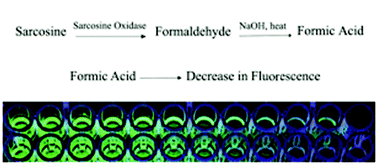A novel enzymatic technique for determination of sarcosine in urine samples
Abstract

* Corresponding authors
a
Department of Chemistry and Environmental Research Center, Missouri University of Science and Technology, Rolla, MO, USA
E-mail:
yinfa@mst.edu
Fax: +1 573-341-6033
Tel: +1 573-341-6220

 Please wait while we load your content...
Something went wrong. Try again?
Please wait while we load your content...
Something went wrong. Try again?
C. Burton, S. Gamagedara and Y. Ma, Anal. Methods, 2012, 4, 141 DOI: 10.1039/C1AY05541K
To request permission to reproduce material from this article, please go to the Copyright Clearance Center request page.
If you are an author contributing to an RSC publication, you do not need to request permission provided correct acknowledgement is given.
If you are the author of this article, you do not need to request permission to reproduce figures and diagrams provided correct acknowledgement is given. If you want to reproduce the whole article in a third-party publication (excluding your thesis/dissertation for which permission is not required) please go to the Copyright Clearance Center request page.
Read more about how to correctly acknowledge RSC content.
 Fetching data from CrossRef.
Fetching data from CrossRef.
This may take some time to load.
Loading related content
